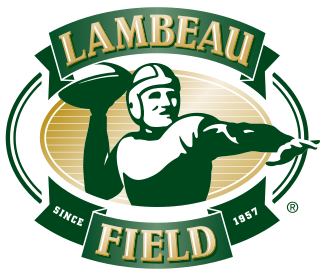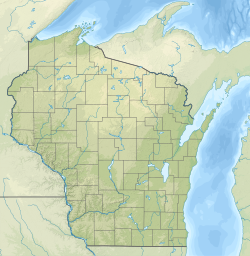
The Green Bay Packers are a professional American football team based in Green Bay, Wisconsin. The Packers compete in the National Football League (NFL) as a member club of the National Football Conference (NFC) North division. It is the third-oldest franchise in the NFL, dating back to 1919, and is the only non-profit, community-owned major league professional sports team based in the United States. Home games have been played at Lambeau Field since 1957. They have the most wins of any NFL franchise.

Earl Louis "Curly" Lambeau was an American professional football player and coach in the National Football League (NFL). Lambeau, along with his friend and fellow Green Bay, Wisconsin, native George Whitney Calhoun, founded the Green Bay Packers in 1919. He served as team captain in the team's first year before becoming player-coach in 1920. As a player, Lambeau lined up as a halfback, which in the early years of the NFL was the premier position. He was the team's primary runner and passer, accounting for 35 touchdowns in 77 games. He won his only NFL championship as a player in 1929.

Lambeau Field is an American football outdoor multi-purpose stadium in Green Bay, Wisconsin. The home field of the Green Bay Packers of the National Football League (NFL), it opened 67 years ago in 1957 as City Stadium, replacing the original City Stadium at Green Bay East High School as the Packers' home field. Informally known as New City Stadium for its first eight seasons, it was renamed in August 1965 in memory of Packers founder, player, and long-time head coach, Earl “Curly” Lambeau, who had died two months earlier.

City Stadium is an American football stadium in Green Bay, Wisconsin, on the north side of the Green Bay East High School property. It was the home of the Green Bay Packers of the NFL from 1925 through 1956. Renovated and downsized, City Stadium remains the home to the adjacent Green Bay East High School athletic teams. Prior to 1925, the Packers played home games at nearby Hagemeister Park and Bellevue Park.

George Whitney Calhoun was an American newspaper editor and co-founder of the Green Bay Packers, a professional American football team based in Green Bay, Wisconsin. After establishing the Packers in 1919 with Curly Lambeau, Calhoun served the team in various capacities for 44 years until his death in 1963. Utilizing his editorial job at the Green Bay Press-Gazette, he became the team's first publicity director, helping to establish local support and interest. He also served as the first team manager and was a member of the board of directors of the non-profit corporation that owns the team. Although often overshadowed by the more famous Curly Lambeau, Calhoun was instrumental to the early success of the Packers. In recognition of his contributions, Calhoun was elected to the Green Bay Packers Hall of Fame in 1978.

The Lumberjack Band was a marching band that played at Green Bay Packers' games. The band earned its name because of the plaid flannel jackets its members originally wore.

The Green Bay Packers are a professional American football team that has played professionally in the National Football League (NFL) since 1921. The team was founded in 1919 by Curly Lambeau and George Whitney Calhoun, and for the next two years played against local teams in Wisconsin and the upper peninsula of Michigan. In 1921, the Packers joined the American Professional Football Association, the precursor to the NFL, with Curly Lambeau as their coach. After falling into financial trouble, the Green Bay Football Corporation, now known as Green Bay Packers, Inc., was formed in 1923. The Packers became a publicly owned football team run by a board of directors elected each year. The team went on to win six NFL championships from 1929 to 1944, including three straight (1929–1931). Along the way, Curly Lambeau, with the help of receiver Don Hutson, revolutionized football through the development and utilization of the forward pass.
The Hungry Five are the five Green Bay, Wisconsin area businessmen who were instrumental in keeping the Green Bay Packers franchise in operation during its early years. They raised funds, incorporated the team as a non-profit corporation, sold stock, established the Green Bay Packers Board of Directors and otherwise promoted the franchise.

Verne Clark Lewellen was an American football player and executive.
The 1919 Green Bay Packers season was their first season of competitive football. The team was formed by Curly Lambeau and George Whitney Calhoun with help from the Indian Packing Company. Lambeau served as team captain, the position closest related to the modern position of head coach, while Willard Ryan served as the official head coach. The club posted a 10–1 record against other teams in Wisconsin and Michigan.
The 1920 Green Bay Packers season was their second season of competition. Mostly playing other independent professional teams in Wisconsin, the team finished with a 9–1–1 record under player and coach Curly Lambeau.
The 1933 Green Bay Packers season was their 15th season overall and their 13th season in the National Football League (NFL). This was the first year of divisional play and Green Bay competed in the Western Division. The team finished with a 5–7–1 record under coach Curly Lambeau, the first losing season in team history. Beginning this season, the Packers began playing some home game in Milwaukee, Wisconsin, at Borchert Field to draw additional revenue, starting October 1, 1933, against the New York Giants.
The 1934 Green Bay Packers season was the franchise's 16th season overall, 14th season in the National Football League, and the 16th under head coach Curly Lambeau. The team improved on their 5–7–1 record from 1933 and finished with a 7–6 record. The Packers played their Milwaukee, Wisconsin home games at Wisconsin State Fair Park.
Billie Rex Kelley was an American football player in the National Football League (NFL) who played tight end for the Green Bay Packers. Kelley played college football for Texas Technological College before being drafted by the Green Bay Packers in the 23rd round of the 1949 NFL Draft. He played professionally for one season, in 1949, recording 17 catches for 222 yards and 1 touchdown. Kelley died in Arlington, Texas, in 2015.

W. Webber Kelly, born William Webber Kelly, was a prominent medical doctor in the state of Wisconsin known for being the third president of the Green Bay Football Corporation, the non-profit organization that owns the Green Bay Packers. Kelly was a practicing physician in Green Bay, Wisconsin, for almost 50 years and a respected civic leader. During his one year as president of the Packers for the 1929 season, the team went 12–0–1 and won its first NFL Championship. Kelly was identified as part of The Hungry Five, a group of Green Bay businessmen who were instrumental in guiding the Packers through multiple financially challenging periods. In addition to his presidency, Kelly served as the team physician from 1921 to 1943 and as a member of the Packers' board of directors from 1923 to 1949. After a falling out with Packers co-founder, head coach, and general manager Curly Lambeau, Kelly resigned from the Board in 1949. Two years later he died of a heart attack at the age of 75. In recognition of his contributions, Kelly was inducted into the Green Bay Packers Hall of Fame in 1994.

Emil Richard Fischer was an American businessman and a football executive for the Green Bay Packers. Fischer was well known in the Green Bay cheese industry, a nationally recognized businessman, and a local civic leader. From 1948 to 1952, he served as the fifth president of the Packers. He is credited with leading the Packers through one of the most difficult periods in the team's history. During his tenure, the team's co-founder and longtime coach Curly Lambeau resigned, the Packers issued their third stock sale, and the National Football League (NFL) merged with the All-America Football Conference (AAFC). He also sat on the organization's board of directors and executive committee from 1935 to 1958. After his presidency ended, he served as chairman of the board until his death in 1958. In recognition of his contributions to the team, Fischer was inducted into the Green Bay Packers Hall of Fame in 2013.

Willard J. Ryan was an American teacher and football coach who served as the first head coach of the Green Bay Packers. Historically, Curly Lambeau has been credited as being the Packers' first head coach, although this is primarily due to the different rules of American football in the early 1900s. In Ryan's era, the head coach was not allowed to communicate with the players while they were playing a game. Lambeau, as team captain, would call the plays during a game and also organized practices, tasks that are now allocated to the head coaching position. Ryan, who also coached the Green Bay West High School football team, only coached the Packers in their inaugural season in 1919, leading the team to a record of . Before his coaching career, Ryan served in World War I in 1918. In 1920, he moved to Minnesota to work as a school teacher and a superintendent of schools. He retired in 1955 and moved to Phoenix, Arizona, in 1961. He died of unknown causes on February 7, 1962, at the age of 71.
















